Sizzling Homemade Fried Rice Recipe: Better Than Takeout Magic
Crafting a homemade fried rice that’s better than takeout can turn an ordinary evening into a culinary adventure.
My kitchen experiments have transformed this classic dish into something truly special.
Lazy weeknight dinners demand simple yet delicious solutions, and this recipe delivers big flavor with minimal effort.
Restaurant-quality results come from a few clever techniques and fresh ingredients.
Fragrant jasmine rice, crisp vegetables, and perfectly seasoned proteins create a symphony of taste in every bite.
Soy sauce and a touch of sesame oil bring depth and authenticity to this crowd-pleasing meal.
Better Than Takeout and Easier Than You Think Fried Rice
Better Than Takeout Fried Rice – Ingredient Breakdown
Main Ingredients:Flavor Enhancers:Better Than Takeout Fried Rice Instructions
Step 1: Warm Up the Cooking Surface
Heat a large skillet or wok over medium-high heat.
Pour in sesame oil and let it shimmer across the pan’s surface.
Step 2: Sauté Fresh Vegetables
Add the following ingredients to the hot pan:Stir-fry the vegetables until they become tender and release their aromatic flavors, which takes about 3-4 minutes.
Step 3: Create Fluffy Scrambled Eggs
Reduce the heat to medium-low.
Gently move the vegetable mixture to one side of the skillet.
Pour beaten eggs into the empty space and cook, continuously stirring, until the eggs are softly scrambled and look light and fluffy.
Step 4: Blend Rice and Seasonings
Introduce cooked rice and soy sauce to the skillet.
Thoroughly mix all ingredients, ensuring the rice gets an even coating of sauce and everything is well combined.
Step 5: Crisp and Heat the Fried Rice
Continue stir-frying the mixture for an additional 4-5 minutes.
This step helps develop a slight crispiness and ensures the rice is completely heated through.
Step 6: Plate and Enjoy
Transfer the fried rice to serving dishes.
Enjoy immediately as a delightful side dish or a satisfying main course.
Fried Rice Tips That Beat Takeout Quality
Reheat Better Than Takeout Fried Rice
Pairings That Elevate Fried Rice
Takeout Fried Rice Custom Mix-Ins
FAQs
Absolutely! Frozen peas and carrots work perfectly and save chopping time. Just thaw them slightly before adding to the skillet.
Simply omit the eggs or replace them with tofu scramble. The dish remains flavorful and nutritious with vegetables and rice.
Day-old cold rice is ideal because it’s less sticky and absorbs flavors better. Jasmine or long-grain white rice are excellent choices.
Use gluten-free soy sauce or tamari to make the recipe completely gluten-free. Check the labels to ensure no wheat-based ingredients are used.
Print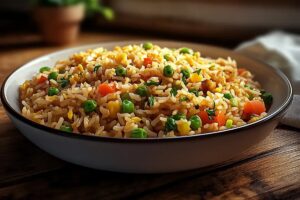
Better Than Takeout Fried Rice Recipe
- Total Time: 25 minutes
- Yield: 4 1x
Description
Chinese takeout meets home-cooked magic in this better than takeout fried rice, a quick and flavorful dish packed with savory goodness. Crispy rice, tender vegetables, and protein come together in a skillet, bringing restaurant-quality comfort directly to your plate.
Ingredients
Main Ingredients:
- 3 cups cooked white rice
- 2 large eggs
- 1 cup frozen peas and carrots, thawed
- 1 small onion, chopped
Seasonings and Flavor Enhancers:
- 1/4 cup soy sauce
- 2 teaspoons minced garlic
Cooking Oil:
- 3 tablespoons sesame oil
Instructions
- Ignite a large skillet or wok with sesame oil, establishing a sizzling medium-high heat foundation for your culinary adventure.
- Introduce a vibrant medley of peas, carrots, onions, and minced garlic into the heated landscape, allowing them to dance and soften while releasing their aromatic essence for 3-4 minutes.
- Gently shift the vegetable constellation to one side of the skillet, creating a dedicated zone for egg transformation, then pour beaten eggs into the cleared space and scramble them into delicate, golden wisps.
- Merge the rice into this flavor-packed terrain, generously baptizing the grains with soy sauce and thoroughly intertwining each component to ensure a harmonious blend of textures and tastes.
- Continue the culinary choreography by stir-frying the entire mixture, allowing the rice to absorb surrounding flavors and reach a robust, steaming temperature.
- Elevate the dish from skillet to plate, presenting a versatile creation ready to shine as either a compelling side or a hearty main course.
Notes
- Swap out regular rice for cauliflower rice to create a low-carb, keto-friendly version that’s equally delicious and nutritious.
- Enhance protein content by adding cooked chicken, shrimp, or tofu during the vegetable stir-frying stage for a more substantial meal.
- Use cold, day-old rice to prevent mushy texture and ensure each grain remains separate and perfectly crisp during cooking.
- Experiment with different soy sauce varieties like tamari for gluten-free options or liquid aminos for a lighter, less salty flavor profile.
- Prep Time: 10 minutes
- Cook Time: 15 minutes
- Category: Lunch, Dinner
- Method: Frying
- Cuisine: Chinese
Nutrition
- Serving Size: 4
- Calories: 400
- Sugar: 2g
- Sodium: 800mg
- Fat: 18g
- Saturated Fat: 3g
- Unsaturated Fat: 15g
- Trans Fat: 0g
- Carbohydrates: 50g
- Fiber: 2g
- Protein: 10g
- Cholesterol: 70mg

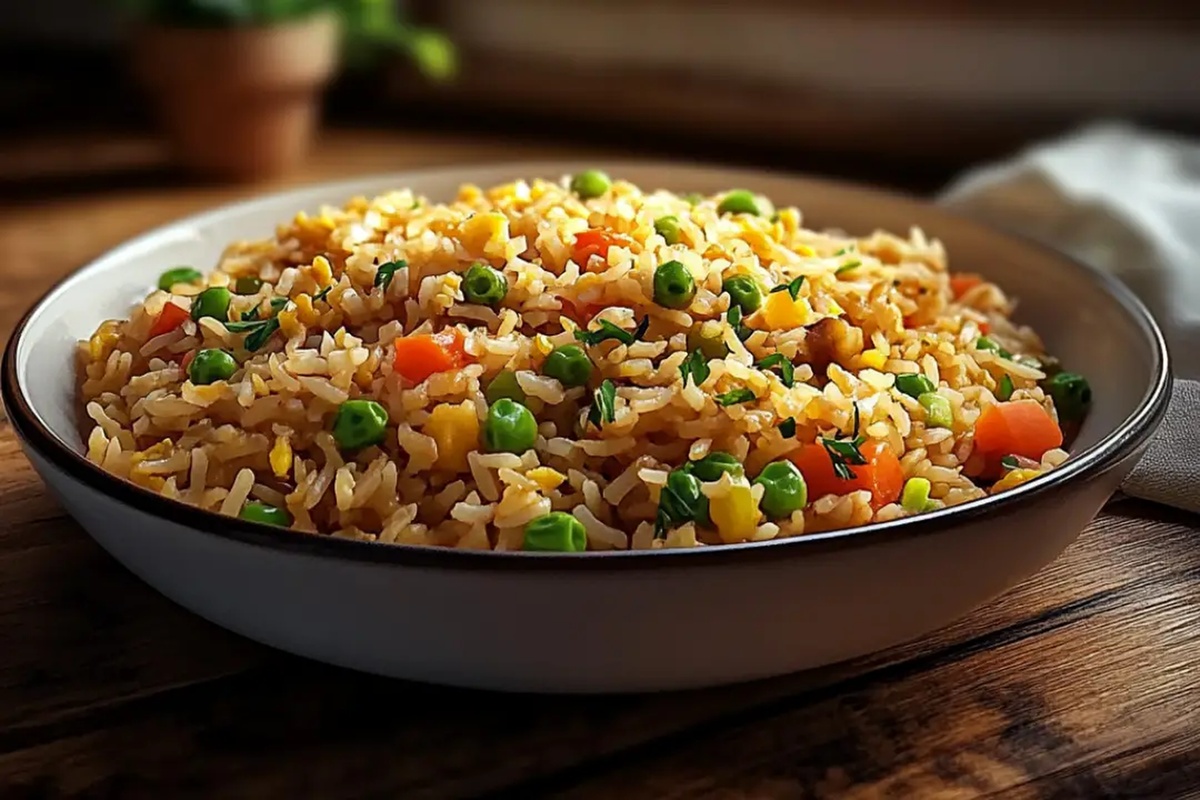
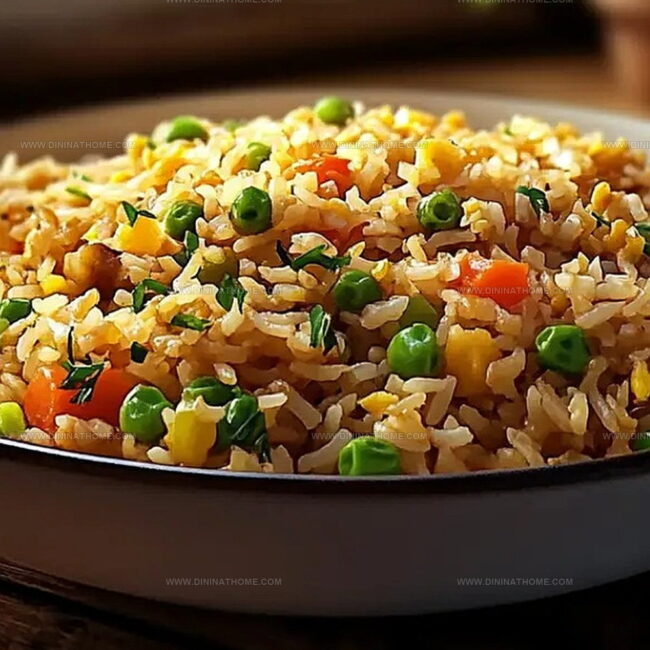
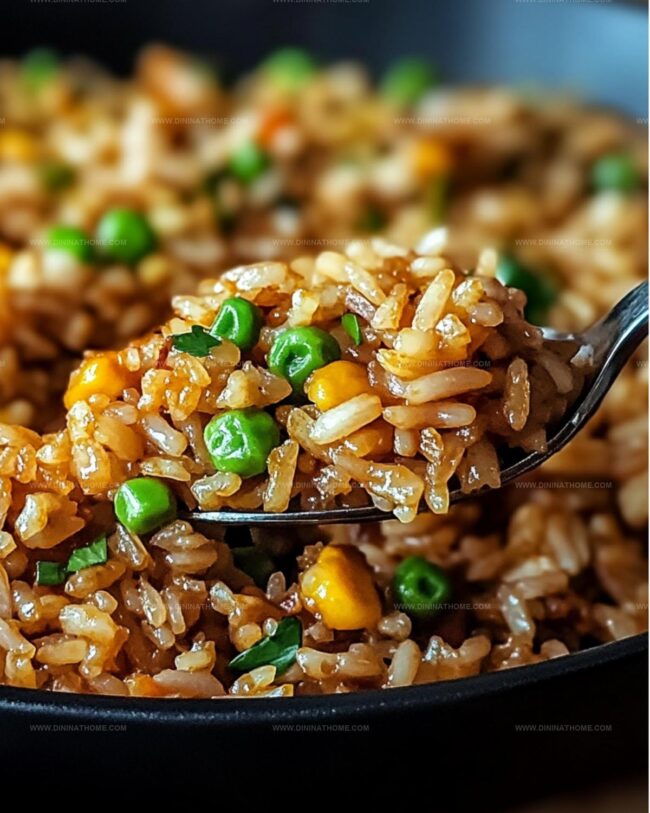
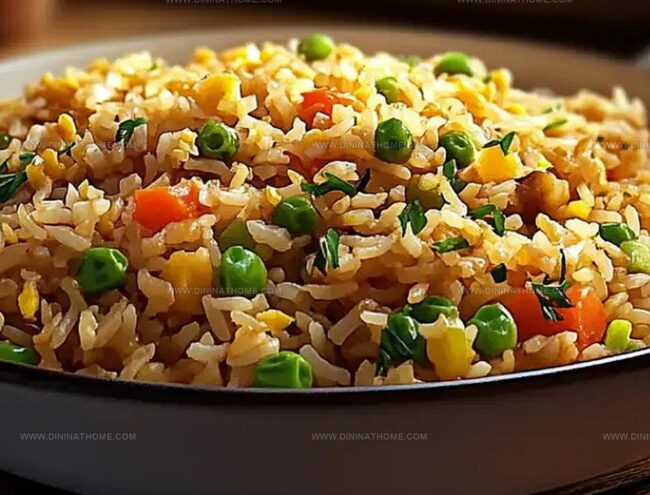
James Walker
Lead Recipe Developer & Culinary Educator
Expertise
Southern Cuisine & Farm-to-Table Cooking, Recipe Development & Testing, Culinary Education & Instruction
Education
School: Auguste Escoffier School of Culinary Arts
Program: Diploma in Culinary Arts and Operations
Focus: Comprehensive training in classical and modern culinary techniques, kitchen operations, and farm-to-table practices.
James didn’t learn cooking from a TV show, he learned it from busy kitchens, family gatherings, and long afternoons spent testing recipes the hard way.
After training at the Auguste Escoffier School of Culinary Arts, he brought his love for real, down-to-earth food to every dish he makes.
At Dining At Home, James loves building recipes that feel familiar but still have something special, like adding a twist to a classic or making a slow Sunday dinner feel brand new.
When he’s not in the kitchen, you’ll probably find him swapping garden tips at the farmers’ market or teaching his daughter how to flip pancakes without a mess (almost).